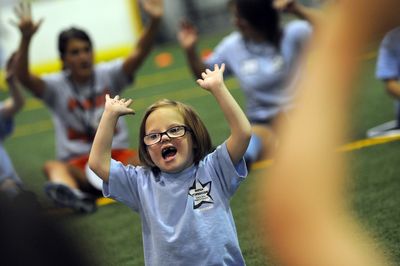TOPSoccer brings kids, buddies out to play
Sports program for children with physical or intellectual disabilities is popular in the area

The Spokane Indoor Soccer Center echoed with the shouts and giggles of children at play.
Each Wednesday until the season ends, dozens of area kids get the chance to score a goal, make a friend, and wear a uniform. A chance they might not have if not for Sharlene “Gus” Schmauch.
Schmauch, a former speech therapist turned stay-at-home mom, became involved with Spokane Valley Junior Soccer Association more than 25 years ago. “I started volunteering when my kids were young and then I ran the office.” Years passed, and when Schmauch retired from her position she knew she wanted to stay involved in the soccer community.
She’d heard about TOPSoccer, a national program for children ages 4 and older who have physical or intellectual disabilities. “We didn’t have TOPSoccer on the East Side of the state,” Schmauch said. So she made it her mission to bring the program to the Spokane area. “Sports activities for special-needs children are very limited.”
With the support of SpVJSA and Spokane Youth Sports Association as well as Washington State Youth Soccer, TOPSoccer, which stands for The Outreach Program for Soccer, debuted in the spring of 2006. Schmauch is quick to acknowledge the help she’s received from committee members Tandie Dahnke, Ryan Spencer and administrative assistant Laurie Lunzer. “Without them the program wouldn’t be the success it is.”
And what a success it’s proven to be. “We thought we’d shoot for 10 kids,” Schmauch said. “We were surprised when 30 kids showed up.”
The program offers fall and spring soccer at the Spokane Indoor Soccer Center. The availability of an indoor location is important. For kids with walkers or braces, playing on rain-soaked fields could lead to injuries.
Equally important is the participation of coaches and buddies. Every child has a buddy who accompanies him/her throughout the practice. Schmauch estimates that over the past two years they have had 150 children participate, in addition to 150 coaches and buddies. They draw their volunteers primarily from the local soccer associations.
“Once coaches start, they seem to get hooked on it,” she said.
Jim Wilson is one of those coaches. “It’s remarkable, seeing how the kids progress,” he said. “A real kinship develops between the buddies, coaches and players.”
At a recent practice Wilson led the players through basic soccer drills. Six-year-old Morgan Reel sat nearby and rolled a ball back and forth to his buddy Veronica Franzese, a University Elementary student. A big grin split Morgan’s face as Franzese took his hand and helped him walk the ball slowly toward the goal. “Good job!” Franzese said when the ball touched the net.
It may look more like controlled chaos than traditional soccer practice, but each child gets one-on-one attention and a chance to participate in a team sport.
“The whole buddy thing sold it for me,” said Stephanie Lloyd. She drives each week from Deer Park to Spokane Valley so her daughter can enjoy this experience. Other parents bring their children in from Medical Lake, Cheney and Colbert. Lloyd’s 6-year-old daughter Meggie has Down syndrome and has been part of the program since she was 4.
For kids like Meggie, the sheer joy of playing with others is more important than advanced soccer skills. “She doesn’t often kick the ball,” her mom said with a laugh. “She spent the whole first year running away from her buddy. She thought that was great fun.” As if to illustrate her mother’s point, Meggie grabbed a foam noodle and handed one end to her buddy. She then began an extended “phone” conversation from her end of the noodle.
The fact that these kids may not be soccer superstars is just fine with Schmauch. “Basically, we want to get them into soccer mode and do some fun games and drills. The most important thing is these kids get a chance to participate in a sports activity.”
Seven-year-old Hayden Stipe glided his walker across the floor and kicked the ball into the goal like a seasoned pro. It was only the second time he’d played. “I like running and kicking the ball!” he said. Even so, he willingly took his turn in the net as goalie. “I’m a very good goalie,” he confided.
Teammate Gracey Heidel managed to slip one past him. “Yes! Yes!” she shouted “I’m crazy about you!” she hollered, and stretching her neck she kissed herself soundly on each shoulder.
Across the room 18-year-old Amy Greenwood let out a groan. “C’mon coach, take it easy on us. Slow down a bit,” she shouted good-naturedly. “My favorite part is kicking a goal,” she said. “But I hate doing sit-ups. Those hurt!”
By the time the kids gathered for cool-down activities, their faces shone with perspiration, but most of them were still grinning.
After practice, Parker Sutherland talked his dad into buying him a well-earned snack from a vending machine. “He’d just started walking at age 4 1/2 when he started this – his buddy held his hand,” said his mother, Heather Sutherland. “He’s gained so much.”
Now the 7-year-old runs across the artificial grass. “I kick the ball,” he said with a grin.
His mother smiled, too. “It’s a complete joy to watch him out there.”